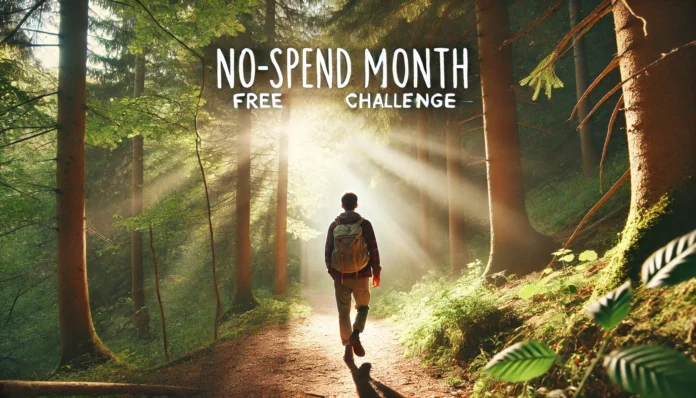The True Impact of Taking on the No-Spend Month Challenge
Embracing the challenge of learning how to not spend money for a month isn’t just about hoarding dollars or suffering through weeks of deprivation. It’s a powerful exercise in self-awareness, financial recalibration, and conscious living. Throughout this journey, participants often discover that their daily purchases—many of which felt essential—were actually habitual, emotionally driven, or simply the result of convenience. By eliminating discretionary spending, even for a short, defined period, you create the space to observe your relationship with money from a new and more empowered perspective.
You may also like: 10 Genius Frugal Living Hacks: Effective Ways to Save Money on Household Bills
The impact of a no-spend month goes far beyond the immediate financial gains, though those are certainly compelling. Saving hundreds of dollars in just thirty days is a transformative outcome, especially for households striving to break free from paycheck-to-paycheck cycles. Yet the true value often lies in the mindset shifts that follow. People who complete the challenge report feeling more in control of their spending, more mindful about where their money goes, and more capable of distinguishing between wants and needs. This clarity often leads to sustainable behavior change long after the month ends, whether that’s cooking at home more often, rethinking impulsive online purchases, or simply delaying gratification to meet larger financial goals.

Redefining Abundance and Reconnecting with Value
Just as importantly, this challenge opens a dialogue about how we assign meaning and value in our lives. When the typical outlets for spending—shopping, dining out, paid entertainment—are stripped away, many people reconnect with activities and experiences that are free but deeply fulfilling. They discover the joy of borrowing books from the library instead of buying them, or the satisfaction of a homemade meal shared with family. They find time for walks, creative projects, or deep conversations—all of which offer richness that money can’t buy. In doing so, they begin to rewire their understanding of abundance and realize that frugal living isn’t about scarcity, but about intentionality.
Frugality becomes a philosophy rather than a constraint. It creates space to appreciate what already exists within your environment, and that reorientation often brings a deeper sense of gratitude. The question shifts from “What can I buy to make me happy?” to “What do I already have that brings me joy?” This shift in perspective isn’t just emotionally rewarding—it’s financially liberating.
Building Resilience and Financial Confidence
For anyone wondering how to not spend any money for a month without feeling restricted or miserable, the answer lies in planning, flexibility, and a willingness to embrace the challenge as an experiment in growth. The discomfort that arises when your usual spending routines are disrupted is temporary, but the insights gained are lasting. Financial stress doesn’t disappear overnight, but this challenge builds the muscles needed to confront it head-on—with discipline, creativity, and resilience.
Learning to do more with less and adapt to temporary constraints fosters resourcefulness and grit. These are qualities that serve you long after the month ends. When faced with unexpected expenses in the future or a dip in income, you’ll know you have the tools and mindset to weather the storm. There’s great peace of mind that comes from knowing you can live well without relying on constant consumption.
Moreover, this challenge often unveils previously hidden financial opportunities. Perhaps you realize that a subscription you paused wasn’t really adding value, or that commuting alternatives could save you $200 per month. These realizations compound over time, contributing to long-term financial wellness and independence.
A Renewed Sense of Purpose and Financial Direction
Ultimately, this frugal living challenge isn’t about perfection. It’s about progress, self-discovery, and crafting a lifestyle that aligns more closely with your values and goals. Whether your aim is to pay off debt, build savings, or simply prove to yourself that you can exercise financial discipline, committing to a no-spend month is one of the most rewarding experiments you can undertake. You don’t just end the month with more money in your account—you finish it with a renewed sense of purpose, a toolkit of frugal strategies, and the confidence that you’re fully capable of steering your financial future in the direction of your choice.
You’ll have seen firsthand how much intentionality can change your spending habits. You’ll know what it feels like to take control of your finances instead of letting them control you. And you’ll likely emerge with a more grounded, less materialistic view of what it means to live well. That’s the kind of financial wisdom that not only saves you money—but can also change your life.
So if you’re still on the fence, ask yourself this: what do you have to lose—other than unnecessary expenses and old habits that no longer serve you? And more importantly, what might you gain.

FAQ: Mastering the No-Spend Challenge—Expert Strategies for How to Not Spend Any Money for a Month
1. What are the most overlooked psychological benefits of learning how to not spend any money for a month?
One of the most transformative psychological shifts from learning how to not spend any money for a month is gaining mastery over impulse control. While many people approach the challenge as a test of willpower, it’s actually an opportunity to understand the deeper emotional triggers behind spending. You may find that boredom, anxiety, or even celebration often pushes you toward unnecessary purchases. Over the course of the month, you develop not just discipline, but a stronger emotional vocabulary for interpreting your spending cues. This self-awareness often lasts well beyond the month and influences future financial behavior in subtle but lasting ways.
2. Can a no-spend month actually reveal hidden income or savings potential?
Absolutely. Many participants in the challenge discover that learning how to not spend any money for a month uncovers surprising amounts of financial leakage. From unused subscriptions to duplicate purchases or forgotten reward points, these areas become much more visible when you’re not constantly transacting. Moreover, by reevaluating what “necessity” really means, many people recalibrate their monthly spending projections permanently, effectively giving themselves a raise without changing income. It’s not uncommon to find $100–$300 in unnecessary monthly expenditures simply by slowing the flow. That alone can supercharge your long-term savings goals.
3. How can social situations be managed when trying to not spend any money for a month?
Social obligations are often the Achilles’ heel of anyone attempting how to not spend any money for a month. However, with a bit of creativity, these challenges can turn into opportunities for deeper connections. Proposing no-cost alternatives—like hiking, potlucks, or movie nights at home—can actually bring people together more authentically. You’d be surprised how many friends are relieved to skip expensive brunches or group gifts when someone else leads the charge. Over time, this shift can also influence your social circle to adopt more mindful and financially sustainable habits.
4. Are there advanced tactics for households who’ve already tried this challenge before?
For seasoned participants, consider leveling up the challenge by incorporating bartering or skill-swapping with neighbors or community groups. For example, offer to babysit in exchange for a home-cooked meal or trade your gardening skills for someone else’s carpentry expertise. These activities expand the value of how to not spend any money for a month beyond avoidance and into creative collaboration. You can also gamify the experience by tracking how many items you can repurpose or upcycle during the month, transforming frugality into innovation. This adds a fresh dynamic that keeps the challenge engaging and sustainable year after year.
5. What are the long-term lifestyle changes that often result from mastering this challenge?
Successfully completing the challenge of how to not spend any money for a month often sparks a minimalist mindset that endures. People begin to value experiences over things, invest more in their relationships, and prioritize quality over quantity in future purchases. There’s also a growing tendency to embrace delayed gratification, which is a cornerstone of wealth building. Many report they feel a stronger sense of financial autonomy and reduced anxiety around money. Over time, these changes contribute not just to a healthier bank balance but to a more purpose-driven life.
6. How can parents involve their children in a no-spend month without creating stress?
Turning the challenge of how to not spend any money for a month into a family mission can actually be a fun and empowering experience for children. Instead of focusing on what you can’t do, frame it as a treasure hunt for free adventures. Involve kids in creating a “fun without spending” calendar with activities like homemade pizza night, backyard camping, or DIY crafts. This not only teaches financial literacy early on but also nurtures creativity and gratitude. Children often mirror the values modeled to them, and this challenge can plant lifelong seeds of financial responsibility.
7. What role does digital minimalism play during a no-spend month?
One unexpected dimension of learning how to not spend any money for a month is confronting digital spending triggers. Disabling one-click purchasing, unsubscribing from promotional emails, and limiting time on shopping apps or social media can drastically reduce temptation. In fact, practicing digital minimalism often supports mental clarity and helps you reconnect with offline interests. Reducing exposure to consumer marketing during the month can reset your relationship with technology and spending alike. These tech-related tweaks can amplify the success of your no-spend effort and lay the foundation for ongoing mindful consumption.
8. Are there global or cultural versions of this challenge that offer unique insights?
Yes, the ethos behind how to not spend any money for a month echoes practices in various cultures that emphasize moderation, intentionality, and community resourcefulness. For instance, in Japan, the concept of “mottainai” instills respect for resources and discourages wastefulness. In Scandinavian countries, the “lagom” philosophy—meaning “just the right amount”—influences financial behavior and encourages balance. By studying these international approaches, participants can add depth to their challenge and potentially adopt a broader, more holistic understanding of frugality. Cultural exploration through the lens of spending restraint can be deeply enriching.
9. How can the challenge be adapted for people with irregular income or freelance work?
Those with variable income may find that practicing how to not spend any money for a month is less about restriction and more about stabilization. One effective approach is to align the no-spend period with a lower-income month, turning necessity into strategy. Alternatively, freelancers can use the month to test operating strictly on last month’s income, reinforcing the pay-yourself-first principle. This not only promotes better forecasting but also softens the emotional volatility that often accompanies inconsistent cash flow. Framing the month as a systems test, rather than a deprivation exercise, empowers freelancers to build resilience.
10. What innovations or future developments could support people trying to not spend money for a month?
Emerging fintech tools and AI-powered budgeting apps are poised to make how to not spend any money for a month more intuitive and personalized. For example, some platforms can now proactively alert users before emotional or pattern-based spending occurs, offering real-time nudges. Additionally, online communities and gamified platforms are turning personal finance into social engagement, providing challenges, milestones, and group accountability. We may also see growth in community economies—like time banks or localized barter systems—that support resource-sharing without cash. As frugality becomes more tech-integrated, the no-spend month could evolve from a grassroots movement into a mainstream, data-supported lifestyle tool.

Conclusion: Why a No-Spend Month Is the Frugal Living Challenge Worth Taking
Committing to a no-spend month is more than just a financial experiment—it’s a powerful shift in how you relate to money, time, and value. When you truly embrace how to not spend money for a month, you begin to see your spending habits in a new light. What once felt automatic becomes intentional. What once drained your bank account begins to fuel your financial goals instead. And what once seemed impossible—living well without spending daily—becomes a proven reality.
This challenge offers more than a few hundred dollars in savings; it rewires your relationship with consumption. You learn to pause before purchasing, to question convenience, and to prioritize long-term satisfaction over short-term gratification. You also gain the skills and confidence to carry this mindset forward, applying the same principles to broader financial goals like building an emergency fund, paying down debt, or even investing in your future.
Perhaps the greatest outcome of learning how to not spend any money for a month is realizing how much abundance already exists in your life. From resources you already own to relationships you can deepen and experiences you can savor, this journey reminds you that wealth isn’t just a number in your bank account. It’s a reflection of how mindfully you live, how aligned your choices are with your values, and how effectively you manage what you have.
So if you’re looking to reset your finances, regain control, and experience the true power of frugal living, there’s no better way to start than with a 30-day spending freeze. You’ll come out the other side with more than money saved—you’ll gain a stronger, wiser version of yourself ready to thrive with less and live with more purpose.
money-saving challenge, zero spend month, frugal lifestyle habits, minimalist budgeting strategies, cut spending fast, spending freeze benefits, save money without earning more, mindful money habits, personal finance discipline, intentional spending choices, curb impulse buying, budget reset challenge, financial detox plan, no spend weekend ideas, household budget overhaul, cash-only budgeting, frugal family budgeting tips, reset spending mindset, conscious consumer habits, smart financial behavior
Further Reading:
What I Learned From My No-Spend Month
Simple ways to save money for the future
Legal Disclaimer
The information provided in this article is for general informational purposes only and is not intended to constitute financial, investment, legal, tax, or other professional advice. The content should not be relied upon for making any financial or investment decisions. Readers are encouraged to consult with licensed professionals, such as financial advisors, attorneys, or tax experts, to obtain personalized advice tailored to their individual circumstances. The author and publisher disclaim any liability for any actions taken or not taken based on the information provided in this article.





